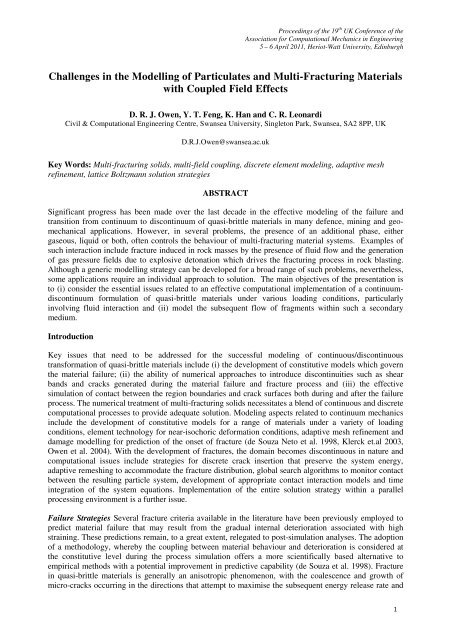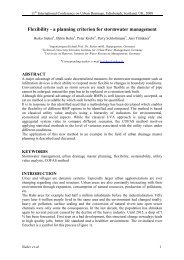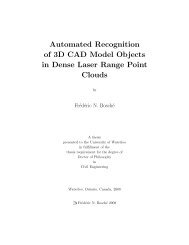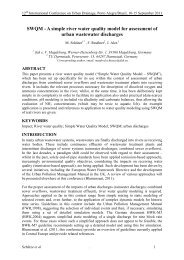ACME 2011 Proceedings of the 19 UK National Conference of the ...
ACME 2011 Proceedings of the 19 UK National Conference of the ...
ACME 2011 Proceedings of the 19 UK National Conference of the ...
You also want an ePaper? Increase the reach of your titles
YUMPU automatically turns print PDFs into web optimized ePapers that Google loves.
<strong>Proceedings</strong> <strong>of</strong> <strong>the</strong> <strong>19</strong> th <strong>UK</strong> <strong>Conference</strong> <strong>of</strong> <strong>the</strong><br />
Association for Computational Mechanics in Engineering<br />
5 – 6 April <strong>2011</strong>, Heriot-Watt University, Edinburgh<br />
Challenges in <strong>the</strong> Modelling <strong>of</strong> Particulates and Multi-Fracturing Materials<br />
with Coupled Field Effects<br />
D. R. J. Owen, Y. T. Feng, K. Han and C. R. Leonardi<br />
Civil & Computational Engineering Centre, Swansea University, Singleton Park, Swansea, SA2 8PP, <strong>UK</strong><br />
D.R.J.Owen@swansea.ac.uk<br />
Key Words: Multi-fracturing solids, multi-field coupling, discrete element modeling, adaptive mesh<br />
refinement, lattice Boltzmann solution strategies<br />
ABSTRACT<br />
Significant progress has been made over <strong>the</strong> last decade in <strong>the</strong> effective modeling <strong>of</strong> <strong>the</strong> failure and<br />
transition from continuum to discontinuum <strong>of</strong> quasi-brittle materials in many defence, mining and geomechanical<br />
applications. However, in several problems, <strong>the</strong> presence <strong>of</strong> an additional phase, ei<strong>the</strong>r<br />
gaseous, liquid or both, <strong>of</strong>ten controls <strong>the</strong> behaviour <strong>of</strong> multi-fracturing material systems. Examples <strong>of</strong><br />
such interaction include fracture induced in rock masses by <strong>the</strong> presence <strong>of</strong> fluid flow and <strong>the</strong> generation<br />
<strong>of</strong> gas pressure fields due to explosive detonation which drives <strong>the</strong> fracturing process in rock blasting.<br />
Although a generic modelling strategy can be developed for a broad range <strong>of</strong> such problems, never<strong>the</strong>less,<br />
some applications require an individual approach to solution. The main objectives <strong>of</strong> <strong>the</strong> presentation is<br />
to (i) consider <strong>the</strong> essential issues related to an effective computational implementation <strong>of</strong> a continuumdiscontinuum<br />
formulation <strong>of</strong> quasi-brittle materials under various loading conditions, particularly<br />
involving fluid interaction and (ii) model <strong>the</strong> subsequent flow <strong>of</strong> fragments within such a secondary<br />
medium.<br />
Introduction<br />
Key issues that need to be addressed for <strong>the</strong> successful modeling <strong>of</strong> continuous/discontinuous<br />
transformation <strong>of</strong> quasi-brittle materials include (i) <strong>the</strong> development <strong>of</strong> constitutive models which govern<br />
<strong>the</strong> material failure; (ii) <strong>the</strong> ability <strong>of</strong> numerical approaches to introduce discontinuities such as shear<br />
bands and cracks generated during <strong>the</strong> material failure and fracture process and (iii) <strong>the</strong> effective<br />
simulation <strong>of</strong> contact between <strong>the</strong> region boundaries and crack surfaces both during and after <strong>the</strong> failure<br />
process. The numerical treatment <strong>of</strong> multi-fracturing solids necessitates a blend <strong>of</strong> continuous and discrete<br />
computational processes to provide adequate solution. Modeling aspects related to continuum mechanics<br />
include <strong>the</strong> development <strong>of</strong> constitutive models for a range <strong>of</strong> materials under a variety <strong>of</strong> loading<br />
conditions, element technology for near-isochoric deformation conditions, adaptive mesh refinement and<br />
damage modelling for prediction <strong>of</strong> <strong>the</strong> onset <strong>of</strong> fracture (de Souza Neto et al. <strong>19</strong>98, Klerck et.al 2003,<br />
Owen et al. 2004). With <strong>the</strong> development <strong>of</strong> fractures, <strong>the</strong> domain becomes discontinuous in nature and<br />
computational issues include strategies for discrete crack insertion that preserve <strong>the</strong> system energy,<br />
adaptive remeshing to accommodate <strong>the</strong> fracture distribution, global search algorithms to monitor contact<br />
between <strong>the</strong> resulting particle system, development <strong>of</strong> appropriate contact interaction models and time<br />
integration <strong>of</strong> <strong>the</strong> system equations. Implementation <strong>of</strong> <strong>the</strong> entire solution strategy within a parallel<br />
processing environment is a fur<strong>the</strong>r issue.<br />
Failure Strategies Several fracture criteria available in <strong>the</strong> literature have been previously employed to<br />
predict material failure that may result from <strong>the</strong> gradual internal deterioration associated with high<br />
straining. These predictions remain, to a great extent, relegated to post-simulation analyses. The adoption<br />
<strong>of</strong> a methodology, whereby <strong>the</strong> coupling between material behaviour and deterioration is considered at<br />
<strong>the</strong> constitutive level during <strong>the</strong> process simulation <strong>of</strong>fers a more scientifically based alternative to<br />
empirical methods with a potential improvement in predictive capability (de Souza et al. <strong>19</strong>98). Fracture<br />
in quasi-brittle materials is generally an anisotropic phenomenon, with <strong>the</strong> coalescence and growth <strong>of</strong><br />
micro-cracks occurring in <strong>the</strong> directions that attempt to maximise <strong>the</strong> subsequent energy release rate and<br />
1













